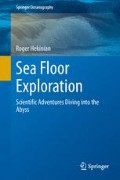Abstract
Planet Earth was formed from the agglomeration of solid bodies. Earth’s iron-nickel enriched core segregated from a silicate mantle as early 30 million years after its formation 4.1–4.7 billion years ago. Earth is the third planet in our solar system circling around the Sun in an elliptical orbit at a distance of 147–152 million kilometers. Such a distance from the Sun enables our planet’s temperature to be hospitable to animal and plant life. Among the nine planets of our solar system, Earth is the only one whose surface environment is adapted for water to exist in its three states: solid, liquid and gas. The elements necessary for life consisting essentially of oxygen, carbon, hydrogen, nitrogen and sulfur, are also found in comets, stars and probably on other planets in the Universe. 71 % of the Earth’s surface is covered by water, which means that when seen from space, our home could be called the “Blue Planet”.
Access this chapter
Tax calculation will be finalised at checkout
Purchases are for personal use only
References
Bell DR, Rossman GR (1992) Water in earth’s mantle: the role of nominally anhydrous minerals. Science 255(5050):1391–1397
Ben-Avraham Z, Nur A, Jones D, Cox A (1981) Continental accretion: from oceanic plateau to alloctonous terrains. Science 213:47–54
Boyet M, Carlson RW (2005) 142Nd evidence for early (>4.53 billion year) global differentiation of the silicate earth. Science 309:576–581
Broecker WS (1985) How to build a habitable planet. ELGEO Press, New York, 291 p
Brownlee D (2008) Comets and the early solar system. Phys Today 61(6):30–35
Convay EJ (1943) The chemical evolution of the ocean. Proc Roy Irish Acad B48:161–212
Dalrymple GB (2001) The age of the Earth in the twentieth century: a problem (mostly) solved. J Geol Soc London Spec Publ 190(1):205–221
Dhuime B, Hawjesworks CJ, Cawood PAA, Storey CD (2012) A change in geodynamics of continental growth 3 billion years ago. Science 335:1334–1336
Gastil G (1960) The distribution of mineral dates in time and space. Am J Sci 258:1–35
Engel AEJ, Engel CG (1964) Continental accretion and the evolution of North America. In Advancing Frontiers in Geology and geophysics, Volume in honour of M.S. Kishnam, Hyderabad, Indian Geophysical Union 17–37
Green DH, Ringwood AE (1969) The origin of basalt magmas. In: Hart PJ (ed) Geophysical monograph No. 13, The Earth’s Crust and Upper mantle, American Geophys Union, pp 489–495
Green DH, Ringwood AE (1970) Mineralogy of peridotite under upper mantle conditions. Phys Earth Planet Inter 3:359–371
Hazen RM (2012) The story of earth. The first 4.5 billion years, from stardust to living planet. Viking, Published by the Penguin Group Inc., New York, 306 p
Hanika R, Boyet M, Blichert-Toft J, O’Neil J, Rosing M, Paquette J-L (2012) The elusive Hadean enriched reservoir revealed by 142Nd deficits in Isua Archean rocks. Nature 491:96–100
Harrison CGA (1968) Formation of magnetic anomalies. J Geophys Res 73:2137–2142
Hekinian R, Binard N (2008) Le feu des abysses. Editions QUAE, France, 175 p
Jacobs JA (1967) The Earth’s core and geomagnetism. Pergamon Press, Headinggton Hill Hall 137 p
Labrosse S, Poirier J-P, le Mouël J-L (2001) The age of the inner core. Earth Planet Sci Lett 190:111–123
Le Pichon X (1968) Sea floor continental drift. J Geophy Res 73(12):3661–3696
Melbom A (2008) The rise and fall of great ideas. Science 319:418–419
Morgan WJ (1968) Rises, trenches, great faults and crustal blocks. J Geophys Res 73:1959–1982
Morgan WJ (1972) Plate motion and deep mantle convection. Am Assoc Petrol Geol Bull 56(2):203–213
Mukhopadhyay S (2012) Early differentiation and volatile accretion recorded in deep-mantle neon and xenon. Nature 486:101–104
Myers JS, Crowley JL (2000) Vestiges of life in the oldest Greenland rocks? A review of early Archean geology in the Godthabsfjord region, and reappraisal of field evidence for >3850 Ma life on Akilia. Precambian Res 103(2–4):101–124
Olsen N, Mandea M (2008) Rapidly changed flow in the Earth’s core. Nat Geosci 1:390–394
Pappalardo RT, Head JW, Greeley R, Sullivan RJ, Pilcher C, Schubert G, Moore WB, Carr MH, Moore JM, Belton JS, Goldsby DL (1998) Geological evidence for solid-state convection in Europa’s ice shell. Nature 391:365–368
Pearson DG, Parman SW, Nowell GM (2008) A link between large mantle melting events and continent growth seen in osmium isotopes. Nature 449:202–205
Schidlowski M (2001) Carbon isotopes as biogeochemical recorders of life over 3.8 Ga. The age and accretion of the earth. Earth Sci Rev 59:235–263
Turikian KK (1968) Oceans Foundation of earth science series. Prentice-Hall Englewood-Cliffs, New Jersey 120 p
Vine FH, Matthews DH (1963) Magnetic anomalies over the spreading ridges. Nature 199:947–949
von Huenen R, Scholl DW (1991) Observation at convergent margins concerning sediment subduction, subduction erosion, and growth of the continental crust. Rev Geophy 29:279–316
Wilde SA, Walker JW, Peck WH, Graham CM (2001) Evidence from detrital zircon for the existence of continental crust and oceans on the Earth 4.4 Gyr ago. Nature 409:175–178
Wilson M (2005) Radioisotope tracers reveal extensive melting in Earth’s distant past. Physics Today, September issue 19–21
Wilson JT (1972) Continents adrift. Scientific American W.H. Freeman and company, California, 172 p
White WM (2013) Geochemistry. Wiley, London 672 p
Author information
Authors and Affiliations
Corresponding author
Rights and permissions
Copyright information
© 2014 Springer International Publishing Switzerland
About this chapter
Cite this chapter
Hekinian, R. (2014). Our Haven, Planet Earth. In: Sea Floor Exploration. Springer Oceanography. Springer, Cham. https://doi.org/10.1007/978-3-319-03203-0_2
Download citation
DOI: https://doi.org/10.1007/978-3-319-03203-0_2
Published:
Publisher Name: Springer, Cham
Print ISBN: 978-3-319-03202-3
Online ISBN: 978-3-319-03203-0
eBook Packages: Earth and Environmental ScienceEarth and Environmental Science (R0)

